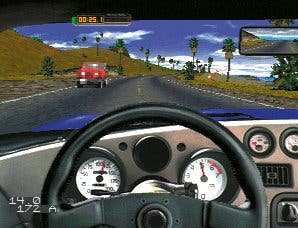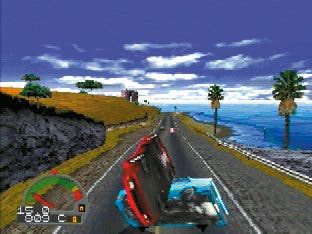Retrospective: The Need for Speed
Back to where it all began on the 3DO.
But the crucial aspect of the Road & Track association ultimately came down to the realism so evident throughout the rest of the game. The grainy, frame-rate-deficient and digitised visuals may look quaint now, but back then there was nothing on home console to touch them. Authentic settings (City, Coastal and Alpine), sampled engine sound and fully detailed two-dimensional recreations of the cars' cockpits ensured the most convincing driving environment seen at the time, combined with a clever 3D rendering system that enabled the road to be drawn to its vanishing point.
And then there's the handling. Supposedly based on data provided by Road & Track, the handling mechanic was hugely impressive for its day, with realistic steering characteristics for each of the cars despite the digital control and an almost palpable weight to the vehicles. This resulted in equally credible crashes, with your ride carrying momentum through every roll or spin until finally coming to a stop, smoke issuing from its bodywork (although no visual damage).

Sure, the physics at work in the original Need for Speed weren't foolproof - one of my favourite tricks involved taking off one of the early hills on the first Alpine stage and overtaking the CPU opponent by landing in front of it - but for the majority of the time taking one of the game's cars out for a spin was an absolute joy.
And that's just it - The Need for Speed isn't so much a racing game as an enthralling driving experience. Yes, you have an adversary and the police are occasionally on your tail, but you soon realise that it's you versus the brilliantly designed road versus the civilian traffic. The slower pace of the action - resulting in part by the CPU demands of the game - deepens the connection with your environment by dictating an authentic sensation of speed. If in doubt, just check out the subsequent conversions of the game which introduced the beginnings of the arcade slant the NFS series has gone on to embody.
The first game, in its first form, however, couldn't be more different. In fact, it's hard to imagine a studio making a game like this now. The Need for Speed is about pushing a series of exotic cars to their limit on treacherous long stretches of road, darting in and out of traffic, and, occasionally, coming across your competitor on-road or outrunning a pesky cop car. Very little happens in the sense of today's set-piece driven productions, yet every drive is a new adventure.

You end up driving aggressively but cautiously, because this is no arcade racing experience. At a time when Daytona and Ridge Racer were entertaining the coin-op crowd, here was a console driving game that was built around realism. It's limited by today's standards, but still reasonably engaging - your body still tenses and you jolt backwards into the sofa as, when doing triple-figure speeds, that grey spec in the distance suddenly turns out to be an oncoming car. Imagine the impact that kind of involvement would have had back in 1994.
Actually, I'll tell you. I became so enthralled by The Need for Speed that I would catch myself subconsciously revving my mum's Metro GTa when I started it up, as I did the cars in the game prior to the start of a stage. Don't worry, I haven't suffered a similar episode since (well, apart from a couple of moments on the motorway around the time I reviewed Gran Turismo 2) but if I brave the risk of everlasting online embarrassment, it's because a game as special as this deserves it.
